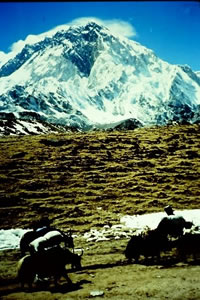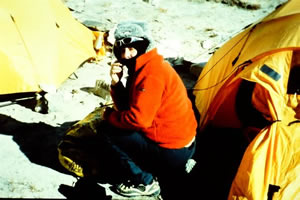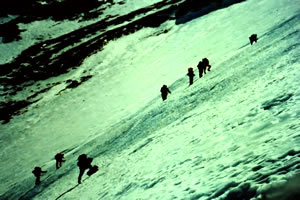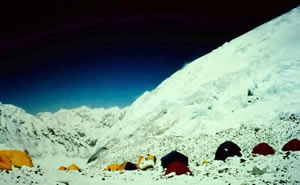
Detailed itinerary, description by day
The hike - distance / time
Kit list for the Intrepid Khumbu Explorers
General Kit:
- Walking poles (not essential, but highly recommended) – can be purchased cheaply in KTM or Namche Bazaar (Day 2 of walk)
- Good trainers or comfortable walking boots. We are extremely unlikely to experience wet weather during our trek and any surface water should be avoidable. Temperatures during the day will vary from 20-25 degrees C (mid to high 70s F) at lower altitudes to 5-20 degrees C higher up – therefore cold feet shouldn’t be a problem.
- Comfortable Ruck-Sack. Capacity of up to 50Litres will be fine. Do NOT overload yourselves – aim for no more than 10Kg, ideally less, on your back. I (RC) will be around to help and we can also employ the services of a porter for the duration – approx $20-40USD/d – dependent on how much food you want his family to eat!!
- Sun-Hat
- Good Sun-Glasses – do not scrimp on these. We are going to high altitude where the harmful sun’s effects are far greater.
- Good Sun-Cream. Look for UVA and UVB cream. NO LESS than FACTOR 20-25. I use P20, which is a once a day preparation – can be bought at the airport. One bottle will look after 2 people for the whole expedition.

Clothing:
- Socks. If you’re wearing boots, then double-looped wool socks tend to go well. Remember, it will be pretty hot on the first few days, so a couple of lighter pairs may be more appropriate. A total of 4-5 pairs will prove luxurious. If we organize ourselves before hand, I could carry in some washing powder for everyone’s use and therefore we could cut this down to 2-3 pairs per person.
- Trousers – trekking trousers probably best but not essential. High wicking, breathable. No particular make recommended. The ones with leg zips mean you have a pair of shorts too, so consider – although I never wear shorts as gaiter area can get very dusty.
- Underwear – depends on your sphincter control re: no. of pairs!! I’ll take 3-4 pairs, but then I am a bit of a woman. Anyone brave enough for just one pair?!!
- 3-4 t-shirts/trekking shirts. I wear cotton – but then I’m a non-conformist. You’ll be most comfortable in the high-wicking stuff. Trekking shirts are routinely made of this and also come with handy pockets – helpful for storage, etc.
- Fleece/Jumper/Light Jacket for colder days/early mornings & evenings. I’m also going to recommend one warm jacket – synthetic or down – so think about these combinations carefully. You need a base-layer (T-shirt) + another 1 or 2 layers to be comfortable. Personally, I take a lightweight windproof jacket + light weight down jacket to go over the top when really cold – although this eventuality has never occurred in 4 previous visits to the Khumbu. So, if you are using a 3 layer system, make sure the outer 2 layers fit over each other. Try not to be tempted to take a warm jacket and an additional Gore-tex jacket. I’ve never seen it rain in the khumbu – it could snow – so your warm jacket will be more than capable of dealing with any snow or light winds that we might experience. This is NOT a trip for Gore-Tex.
- Warm hat, ideally able to cover those cold ears!

To Carry in your Ruck-Sack:
- Water container. Personally, I use a Camelbak. This is in the form of a 2L reservoir bag in an overlying protective outer. Look at the website http://www.wiggle.co.uk They sell these at a reasonable price – just go for the 2L reservoir bag with mouthpiece. It’s around ₤25 including postage. It will slip into your ruck-sack. The beauty of these is that it makes you drink constantly throughout the day, therefore minimizing your risks of dehydration and associated symptoms of lethargy, headache & loss of appetite. You can of course take a couple of water bottles, but the action of stopping, taking your ruck-sack off and getting the bottle out tends to be a disincentive to hydration. Remember, there are plenty of places to stop and buy drinks, every day along the route, so we should never have an excuse for being thirsty.
- Sleeping Bag. This is not essential and therefore consider carefully if you are going to bring one. It should make you comfortably warm arguably to temps of around -10degrees C, although in the lodges, it is unlikely to get this cold. But, there is no heating in the warms, so beware the cold moments from undressing to getting in the bed. Regarding taking a sleeping bag:
Pros: Your bag, your hygiene. Snug, etc. However, all of the lodges that we will be staying in are owned by either friends of me (RC) or families of the sherpas that will be climbing with me later on the mountain, so we will be well looked after. The general standard of lodge bedding provided is excellent – clean and with enough warmth, but you can’t account for other trekkers/climbers and if you pick up knits from somebody else, it’s a long way to have an itch! Having said that, it’s extremely unlikely, as wildlife (insects) is fairly rare in the hypoxic atmosphere in the Upper Khumbu Valley.
Cons: The extra say 2Kg of sleeping bag may not feel like much at the beginning of the day, but by the end, you may be regretting having it on your aching back. You don’t need it, and the ‘lighter the better’ with respect to pack weight.
Bottom line – do what you are comfortable with, but if you are leaning to NOT taking one, I think that this is arguably better (Having said that – I take mine!!).

- Toilet roll. Can be purchased in the Khumbu, but home brands better. 1 roll should be enough
- Medical Kit. I have DIAMOX in my kit, so simple analgesia like paracetamol and Brufen a good addition. Also, Codeine Phosphate might be a helpful top end analgesic. Tracy and myself will be able to help with this. Other than that, a course of ciprofloxacin, metronidazole and augmentin would be beneficial if any of us get traveller’s diarrhoea, chest or skin infections. Plasters for blisters+/- talcum powder may also be a nice idea. Savlon/antiseptic cream/spray. Antiseptic Handwash for after toilet hand care!
- Camera
- Diary and pen – if that way inclined
- Guidebook – but hopefully I should be able to give you a lot of user-friendly info, plus some of the sherpas (Ang Nuru keen to see you all). Try and only bring 1 book between you to save on weight.
- Toiletries. It is possible to pay for a hot shower, probably up until 2 days before base camp, so a small bottle of shampoo should cater for a group of 4 – if we organize ourselves again. Toothpaste/brush, deodorant – if you want to keep the rest of us as friends. A towel if you’re a showering type – light travel towels the best – light and quick drying.
- Music source – if you want to listen to some music on the trail. Can sometimes help if you’re having a difficult day.
- Gloves. I don’t really think that anything major is required. Windproof ones may be best – like a ski glove, but unnecessary to buy a very expensive pair. I just take a light pair of cotton liners, and if gets particularly cold, I have a lightweight windproof pair to put on over the top. In reality, during the day, it will never get that cold. At night, we will be sitting around a yak dung heater after a full day’s trekking, feeling nice and snug, or be in bed. You will NOT get FROSTBITE of your digits on this trek!
- Spare Batteries.
|